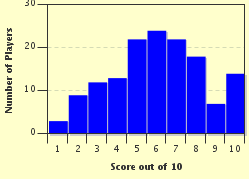Quiz Answer Key and Fun Facts
1. Julia Child had two other co-authors in "Mastering the Art of French Cooking, Volume One". How many co-authors worked with her on "Mastering the Art of French Cooking, Volume Two"?
2. Julia starts Volume Two with a chapter on soups "from the garden" and "bisques and chowders from the sea". She gives us very complicated instructions for making a Lobster Bisque from a whole fresh lobster. What is the French name for this delicacy?
3. In Chapter Two Julia goes into much detail about how to make such complicated things as croissants and puff-pastry from scratch. But she also makes a plain French baguette, telling us what the four ingredients, and only four, should be. What are these ingredients?
4. In Chapter Three Julia gives recipes for wonderful meat creations. One of the finest and most impressive is "Filet de Boeuf en Croute", which means a whole Beef Tenderloin in a Pastry Crust. What is this dish usually named when listed on menus in English?
5. In Chapter Five, Julia talks about all the Pate, Sausage and other delicious meats that can be made out of "pork, veal, chicken, duck, truffles" and so on. In France when a selection of these is served together at the table, it is referred to by a collective name. What is this collective name that Julia also uses?
6. Julia Child gives a recipe for a large potato cake called "Pommes Anna". She says that this very yummy side-dish was created during the reign of Napoleon the Third.
7. Julia makes a version of the famous Baked Alaska ice cream dessert, the one with the ice-cream covered in cooked meringue. However, she adds a French touch - the name might help with the answer - "La Surprise du Vesuve". What do you think the surprise is?
8. Near the end of "Mastering the Art of French Cooking Vol. 2", for our convenience, Julia lists a descriptive index of thirty-six recipes for certain items that we can use to enhance meat, poultry or vegetable dishes. What are these items?
9. On page 518-555, the last section of Mastering the Art Volume 2, Julia lists what she sees as the essentials of a "Batterie de Cuisine". What does she mean by that?
10. Julia Child dedicated her second volume of "Mastering the Art of French Cooking" to her publisher, mentioning that not only did he appreciate good writing, but also that he appreciated fois gras. Who is this publisher?
Source: Author
smeone
This quiz was reviewed by FunTrivia editor
WesleyCrusher before going online.
Any errors found in FunTrivia content are routinely corrected through our feedback system.

